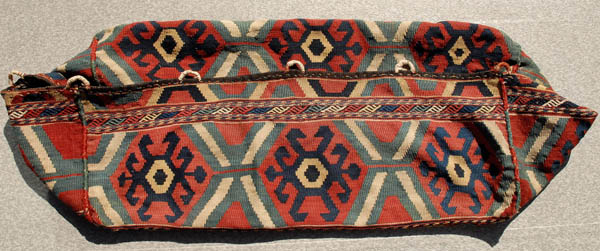
Home Page Discussion
The Salon du Tapis d'Orient is a moderated discussion group in the manner of the 19th century salon devoted to oriental rugs and textiles and all aspects of their appreciation. Please include your full name and e-mail address in your posting.
Kurd, Caucasian or Shahsavan?
by Patrick Weiler
This pile-woven mafrash panel was described as Kurdish. Could it, instead, actually be Shahsavan?

It is 38” wide and 18” tall. There are approximately 5x6 symmetric knots per square inch, for a very coarsely woven, moderately depressed 30 kpsi. There are 7 colors, including a light brown/camel color that appears to be undyed and is the same color as the wefts. It has 3-ply ivory warps in the vertical orientation, woven similarly to most mafrash pieces. The wefts are a natural light brown, with two shots per row of knots. The selvages may not be original. They consist of two thick ivory warps reinforced with wool of a pinkish color not used elsewhere in the weaving. This is because mafrash faces were attached to the end panels differently than a standard rug-type selvage.

Kurdish attributions or NW Persian descriptions of rugs and bags are often used when the piece does not fall into any other discernable category. Parviz Tanavoli wrote an article on Shahsavan pile weavings in 1989 (Hali 45). In it, he noted that his book, Shahsavan, included only two plates of pile-woven pieces, an indication of the relative paucity of Shahsavan pile weaving. Several of the rugs he showed in the article had been previously published as Kurdish or NW Persian. He mentions that Shahsavan pile weaving seems to have stopped around 1910 and not restarted until the 1950’s.
Tanavoli described the construction of Shahsavan pile weavings as usually having symmetric, flat knots, soft wool and a flexible handle. This piece has the soft wool and flexible handle, but the knots are somewhat depressed, although there are areas with flat knots. This may be due to the coarse weave and weaving technique used. The maroon color has corroded and is lower than the surrounding colors. The black is also corroded, but not as severely. Other characteristics of Shahsavan pile weavings are two weft shots, usually pink-red, except for those from the Hashtrud/Khamseh areas, which have ivory or brown wefts (as this piece does). The warps of Shahsavan pieces are two or three ply ivory or salt-pepper wool. This mafrash has three ply ivory warps. The pieces in the Hali article had knot counts from a low similar to this piece of 5x6 knots per square inch, up to 8x8 knots for 64kpsi. All were fairly loosely woven. A brief review of Kurdish weavings from various books did not show any analogs to the design of this piece. There are many Shahsavan flat weaves with a similar design, though. Here is one:

It is 39” wide and 21” tall, approximately the same as the pile piece.
The basic gul or medallion shape and design are quite similar in both pieces, although the pile piece has “bird-head” terminations on the tops of the main motifs. Both have the “fork” endings to the middle extensions and plain ends to the top and bottom extensions.
Also note the lower white half minor gul to the right of the central medallion in the pile piece. It has a red diamond in it with a sideways H figure in the diamond, which can be clearly seen from the photo of the back, at the lower left. This is similar to the H designs in the half minor white guls in the flatweave piece and it is a common device in slitweave kilims.
The major and minor borders are different in these two pieces, but the pile piece has a white-ground vine-meander with triangles, common in Caucasian and Shahsavan kilims.
Here is another piece with bird-head endings on the arms:

It is quite similar to plate 134 in the Wright and Wertime book, Caucasian Carpets and Covers. Their piece is described as Azeri bedding bag/mafrash similar to Kara Koyunlu Kazak kilims. Plate 94 in Oriental Rugs from Atlantic Collections, published in conjunction with the 8th ICOC in Philadelphia (1996), is described as Shahsavan. It has a boteh field “typical of northwestern Iran” with a box in the center of the field with a “beetle-bag” Shahsavan design. The borders are a rendition of the typical Caucasian “crab” border. This indicates that Shahsavan weavers did copy their flatweave designs into pile weavings. Plate 97 of the same book has a rug with a minor border that at first glance would make one assume it was Kurdish, but the authors say that the Kaikalik cross designs (also seen in the field of plate 94) “make a Shahsavan attribution likely.”
So, is this just a Kurdish copy of Shahsavan or Caucasian designs? I am not familiar with Kurdish pile mafrash pieces, although there are some Kurdish pieces of a similar shape. Most of those, however, are of a two-panel design.